YORKTOWN BATTLEFIELDYORKTOWN, VIRGINIA |
 |
YORKTOWN BATTLEFIELDYORKTOWN, VIRGINIA |
 |
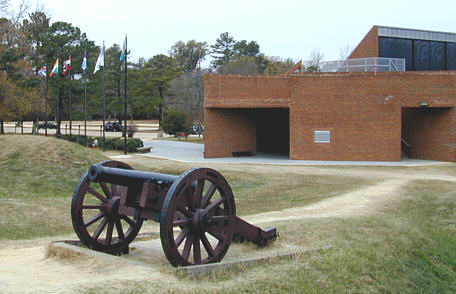
The Yorktown Battlefield is maintained by the National Park Service as a Colonial National Historical Park. There is a small park entrance fee that is payable at the visitor center where the events of the siege of Yorktown are presented in a theater program and several exhibits.
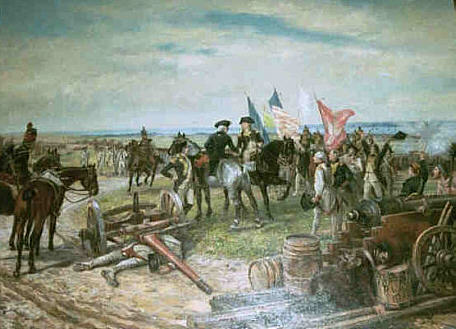 |
|
Converging on Yorktown “This place is in no state of defense. If you cannot relieve me very soon, you must be prepared to hear the worst.” — Lord Cornwallis, British commander at Yorktown, September 17, 1781. “The present moment...will decide American independence and glory and superiority of the Allies.” — George Washington, General Orders near Yorktown, September 20, 1781. In 1781, France became an ally of the United States and the Revolution soon grew into an international conflict that eventually involved most of the major nations of western Europe. The wider scope of the war forced Great Britain to fight on several fronts, as well as to contend with French naval power. Nonetheless, by 1781 the prospects for American independence still looked bleak. The British had overrun part of the south and still held New York, while Washington’s army in the north had been shaken by two unsuccessful mutinies. The tide, however, turned in the autumn, when American and French forces succeeded in trapping a British army at Yorktown. (Yorktown Battlefield Marker) |
British Inner Defense Line — Early in August 1781 Cornwallis began to fortify the Town of York and Gloucester Point across the river. On September 28th, the Allied Army of American and French forces, numbering more than 17,000 men, marched to Yorktown for the siege of Cornwallis’ garrison of about 8,000 men. After their arrival, Cornwallis withdrew his troops from most of his outer defenses to consolidate his position behind the earthworks of his inner defense line.
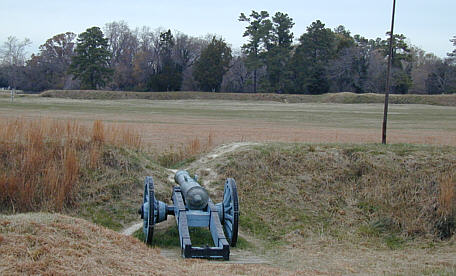 |
|
First Allied Siege
Line The Grand French Battery formed part of the first Allied siege line around Yorktown. French and American soldiers worked through the night of October 6, 1781, to establish the line from a point about one hundred yards across the road to the York River. Largest gun emplacement built during the siege, the Grand French Battery opened fire on October 10 and inflicted great damage on the British. A French officer noted that “...the superiority of the fire of these different batteries over those of the enemy, silenced the firing from the town.” This superiority in artillery contributed greatly to Allied victory. The National Park Service has reconstructed most of the Grand French Battery on its original site and equipped it with original and replica Revolutionary War period artillery. (Yorktown Battlefield Marker) |
Grand French Battery — After a week of preparation, the Allied Army of American and French forces under the cover of darkness constructed its first siege line during the night of October 6th. The siege line extended from the Grand French Battery to the York River. On October 9th, Allied artillery opened fire on the British and the bombardment began. The Grand French Battery was the largest gun emplacement on the first siege line.
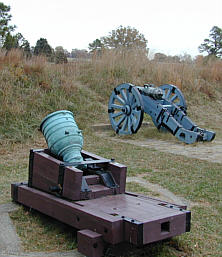 |
Grand French Battery These three batteries and redoubt were a continuation of the Grand French Battery complex across the road. Occupying a section 1,000 feet from east to west, this battery complex contained approximately thirty pieces of artillery which bombarded the main British Defense a half-mile away. So effective was its work that the digging of the Second Parallel could take place one day after the Grand French Battery opened fire. (Yorktown Battlefield Marker) |
Second Allied Siege Line — On October 11th, Allied troops began a second siege line within point blank artillery range of the British. However, the line could not be completed, because two small, detached British earthen forts, Redoubts 9 and 10, blocked the way to the river.
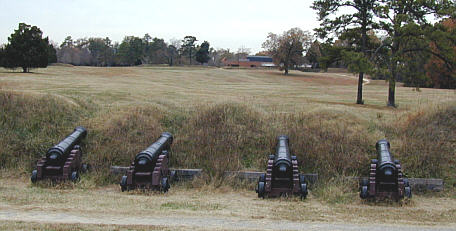 |
|
Second Allied Siege Line Sieges—18th century style. Eighteenth century military commanders conducted sieges according to formal step-by-step procedures perfected over centuries of European warfare. The siege of Yorktown followed the principle of digging successive trenches ever closer to the enemy fortifications. This tactic was still being used in World War I. (Yorktown Battlefield Marker) |
Redoubts 9 and 10 — On the night of October 14th, French troops attacked Redoubt 9 while American troops stormed Redoubt 10, capturing both positions in less than 30 minutes. This allowed the Allies to complete the second siege line and construct a Grand American Battery between the two redoubts.
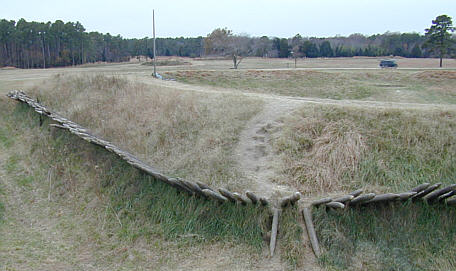 |
|
Redoubt 9 “Anyone can imagine what happened once we were inside the redoubt. People of four nations were thrown together: Frenchmen, English, Scots, and Germans … the soldiers … were so furious that our people were killing one another: The French were striking down everyone in a blue coat. Since the Deux-Ponts wore blue, many of us were stabbed to death. Some of the Hessian and Anspach troops [German units in the British army] wore uniforms almost identical to ours, and the English wore red that in the dark of night seemed blue as well, so things went very unmercifully…” Private Georg Daniel Flohr, Royal Deux-Ponts Regiment. Baron Antoine de Viomenil had overall command of the French attack on Redoubt 9 which was defended by approximately 120 British and German forces. Viomenil selected Colonel en Second Guillaume des Deux-Ponts to head the 400-man assault column from the Gatenais unit and the German re-cruited Royal Deux-Ponts Regiment. The French approach was delayed as pioneers (engineering troops) cleared obstructions protecting the British perimeter. Darkness, the chaos of close-quarter combat and the confusion of German commands coming from both attackers and defenders compounded the difficulties of the assault. Within 30 minutes however, Viomenil was congratulating Deux-Ponts on taking the redoubt. The last obstruction to the Allies completing their Second Siege Line had fallen. (Yorktown Battlefield Marker) |
Cornwallis, realizing his forces were trapped, attempted to move them across the York River and escape on the night of the 16th. However, the attempt was abandoned when a storm interrupted the crossing and prevented its completion.
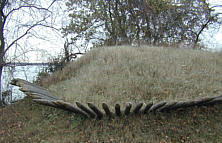 |
Redoubt 10 “The column marched in silence, with guns unloaded, and in good order. Many, no doubt, thinking that less than one quarter of a mile would finish the journey of life…” Captain Stephen Olney, 1st Rhode Island Regiment. The Marquis de Lafayette selected the light infantry companies from his Continental Army division to carry out the American attack on Redoubt 10. Lieutenant-Colonel Alexander Hamilton led the assaulting force of 400 Americans against the 70 British defenders. (Yorktown Battlefield Marker) |
The second siege line was completed the morning of October 17th. That same day, after nine days of round-the-clock bombardment and now facing direct fire from Allied artillery, Cornwallis requested a cease-fire to discuss surrender terms.
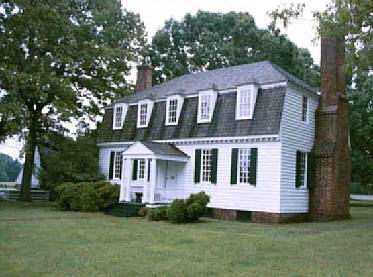 |
|
Moore House The battlefield was quiet October 18, 1781 under temporary truce. That day two Allied commissioners met with two British [commissioners] and drafted the terms of surrender. They met in this house, now restored and refurnished. It was then the home of Augustine Moore, merchant of Yorktown. (Yorktown Battlefield Marker) |
Moore House — On October 18th, officers from both sides met at the home of Augustine Moore to negotiate the surrender terms for Cornwallis’ army.
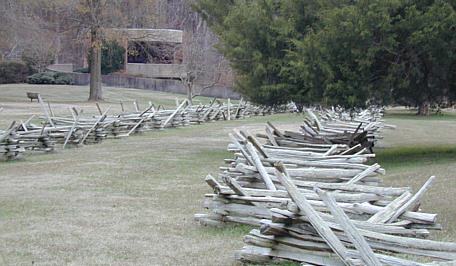 |
|
Surrender Road The course of the road here is about as it was in colonial times. On October 19, 1781, in the afternoon, the solders of Cornwallis’ Army marched this way and filed off into the field on your left. This was the place designated for the formal capitulation of the British Garrison. (Yorktown Battlefield Marker) |
Surrender Field — On October 19th, Cornwallis’ army marched onto Surrender Field and laid down its arms. However, missing from the surrender formalities was the British Commander, Lord Cornwallis, who claimed he was indisposed. Instead, his deputy, General O’Hara attempted to surrender his sword to General Rochambeau. However, Rochambeau, recognizing a possible attempt to not recognize the American forces in the victory, refused to accept the sword and indicated that it should be given to General Washington. However, Washington, unwilling to accept the sword from a deputy, also refused the sword and indicated that it should be surrendered to his deputy, General Lincoln. Lincoln accepted the surrender sword.
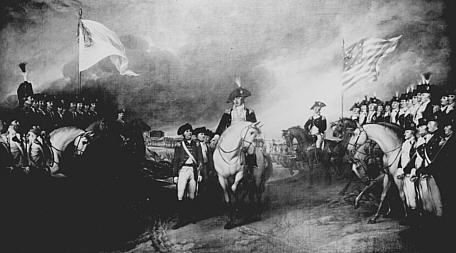
When the British prime minister, Lord North, learned of Cornwallis’ defeat, he reportedly said, “Oh God! It is all over!" The American victory at Yorktown, the last major battle of the American Revolution, secured independence for the United States and significantly changed the course of world history.
After the British surrender, the French forces remained in the Yorktown area during the winter while Washington and most of the American troops returned to New York to keep General Clinton bottled up in New York City. In the summer of 1782, General Rochambeau and his troops departed for New England and left for France in December. Washington kept the American army intact for two more years, until the Treaty of Paris officially ended hostilities in September 1783.
The Town of York —
Yorktown Victory Monument — Authorized by the
Continental Congress after the Allied victory in 1781, construction began a
hundred years later during the centennial celebration of the surrender in 1881.
The monument, which is nearly a hundred feet high, is topped with a figure of
Liberty.
 |
Yorktown Victory Monument This monument was authorized by Continental Congress, October 29, 1781, just after the news of surrender reached Philadelphia. Actual construction began 100 years later and was completed in 1884. The original figure of Liberty atop the Victory shaft was severely damaged by lightning. A new work replaced it in 1956. The shaft of Maine granite is 84 feet in height to which Liberty adds another 14 feet. (Yorktown Marker) |
Secretary Nelson House — The home was Cornwallis’ headquarters during the siege of Yorktown.
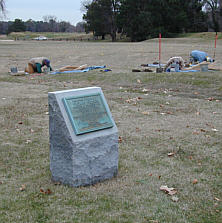 |
Secretary Nelson House Thomas, a son of “Scotch Tom,” who established the Nelson family in Yorktown, was for many years Secretary for the Colony of Virginia. This comfortable and spacious home attracted Lord Cornwallis who needed a headquarters near his main defense on the east side of town. The British commander remained here through much of the siege — until Allied gunners made the house untenable. Its foundations are to your left. (Yorktown Marker) |
Dudley Digges House — Built about 1760 by Digges a lawyer and Virginia government official, 1752-81. Along with Daniel Boone, Digges was also one of the seven members of the Virginia assembly that was captured during the surprise British raid on Charlottesville (a previous site on this road trip).
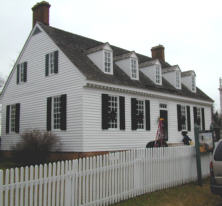 |
Dudley Digges House, circa 1760 “...Lieutenant-colonel Tarleton directed them to charge into the town, [Charlottesville, Virginia]… and to apprehend, if possible, the governor and assembly. Seven members of the assembly were secured...and several officers and men, were killed, wounded, or taken.” Lieutenant-Colonel Banastre Tarleton, A History of the Campaigns of 1780 and 1781. |
|
Dudley Digges built this classic Virginia Tidewater style home around 1760. The outbuildings, wellhouse, kitchen, granary, and smokehouse are typical of those found in the colonial era. The house was restored in 1960 and the outbuildings were reconstructed by the National Park Service in the 1970s. One of the members of Virginia assembly captured by the British during their Charlottesville raid on June 5, 1781 was the former lieutenant governor, Dudley Digges. Digges’ capture ended his prominent political involvement in the American Revolution. The Digges family participated in colonial government since the immigration in 1650 of Dudley’s great-grandfather, Edward Digges, from England. Dudley was born around 1728 and by his early twenties was a practicing lawyer in York County. He served in the House of Burgesses from 1752 until the start of the American Revolutionary War. Throughout the war, Dudley remained active in numerous areas of Virginia government, including helping to write the commonwealth’s first constitution and becoming one of the first members of the state council. Dudley’s home, like so many other Yorktown houses, was damaged during the 1781 siege and rendered uninhabitable. Dudley moved to Williamsburg and died there in 1790. (Yorktown Marker) |
|
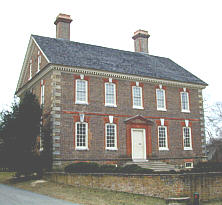 Nelson House — It was the home of Thomas Nelson Jr.,
who led the local "tea party" and tossed the tea that was consigned to
the Prentis Store in Williamsburg off a merchant ship in Yorktown harbor in
November 1774. From 1761 to 1775, Nelson served in the Virginia House of
Burgesses and then two years as a delegate to the Second Continental Congress in
Philadelphia where he signed the Declaration of Independence. In June 1781, he
was elected the third governor of Virginia, succeeding Thomas Jefferson, and,
with the rank of brigadier general, commanded the Virginia militia at the siege
of Yorktown.
Nelson House — It was the home of Thomas Nelson Jr.,
who led the local "tea party" and tossed the tea that was consigned to
the Prentis Store in Williamsburg off a merchant ship in Yorktown harbor in
November 1774. From 1761 to 1775, Nelson served in the Virginia House of
Burgesses and then two years as a delegate to the Second Continental Congress in
Philadelphia where he signed the Declaration of Independence. In June 1781, he
was elected the third governor of Virginia, succeeding Thomas Jefferson, and,
with the rank of brigadier general, commanded the Virginia militia at the siege
of Yorktown.
Smith House — Home of Lieutenant Governor David
Jameson at the time of the 1781 siege.
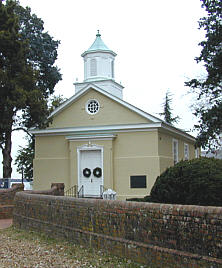 |
Grace Church The sturdy marl walls of this church have been standing since 1697 despite the ravages of war during the two sieges of Yorktown (1781 and 1862) and despite the “great fire” of 1814. It continues, as it has for generations, to serve York-Hampton Parish in the Protestant Episcopal Diocese of Southern Virginia. (Yorktown Marker) |
Grace Church — Built about 1697, this still-active church served the York-Hampton Parish in colonial times.
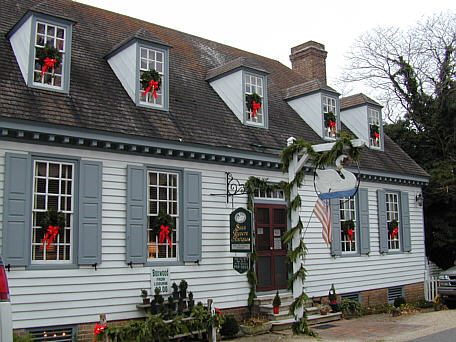
Swan Tavern — Reconstructed tavern is built on the original 1722 site.
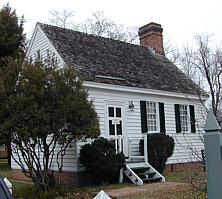 |
Medical Shop (Reconstructed) Dr. Corbin Griffin was a prominent Yorktown physician active in the American Revolutionary War, serving as a surgeon with Virginia forces. During the Siege of Yorktown, he was imprisoned by the British on a ship anchored in the York River. During his confinement, his “cellar down the water side” was pilfered by sailors from the British sloop Bonneta while other British troops took items from his medical shop. “I must...request that your Lordship will inform me of the Reason of Dr. Griffin’s confinement on Board of one of your Prison Ships.” — Governor Thomas Nelson, Jr. to General Charles Lord Cornwallis, September 25, 1781. (Yorktown Marker) |
Medical Shop — Reconstructed 18th-century medical shop of Dr. Corbin Griffin. Dr. Griffin was imprisoned by the British during the siege of Yorktown.
Overnight in the Yorktown-Williamsburg Area — There are many possibilities for lodging in the area, but the Colonial Houses of Williamsburg presents a unique opportunity to stay in an 18th century, colonial home in the heart of Williamsburg. Each home is furnished with period reproductions and range in size from small, single bedroom homes to large family homes with over a dozen rooms. A home can be reserved at 1-800-447-8679 or at www.colonialwilliamsburg.com.
